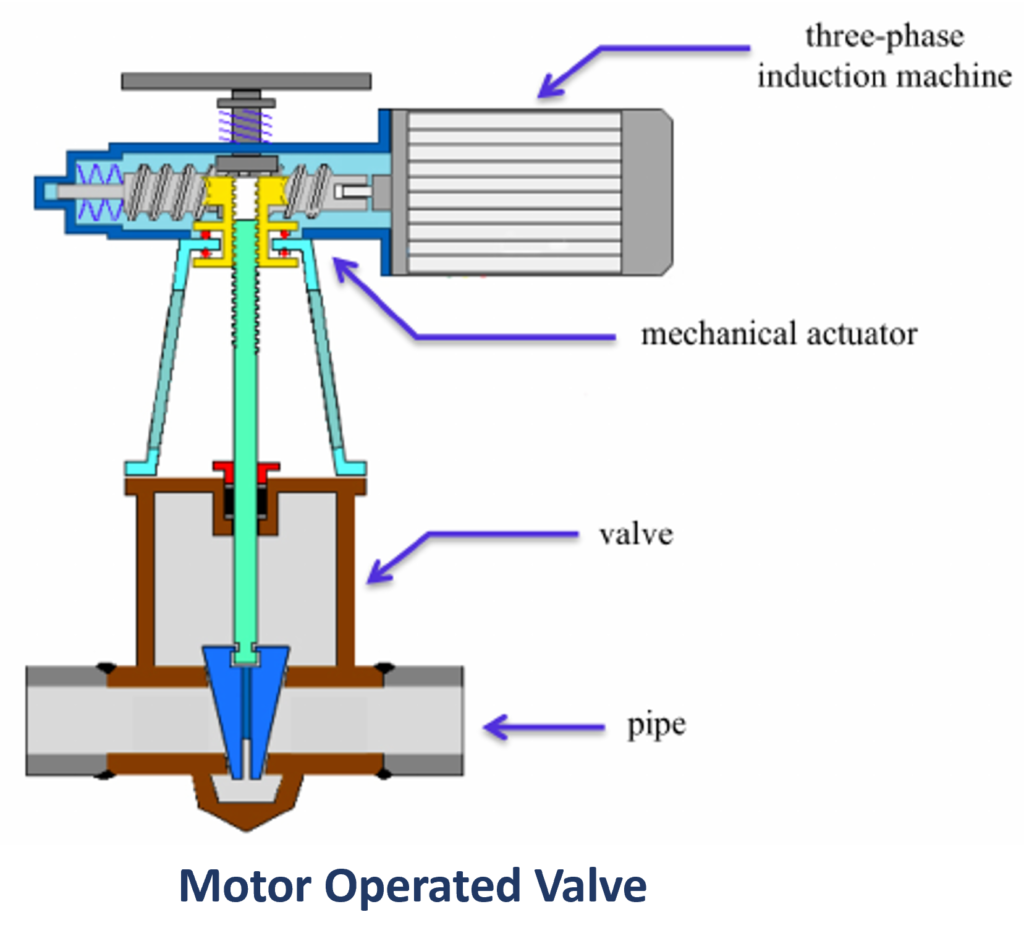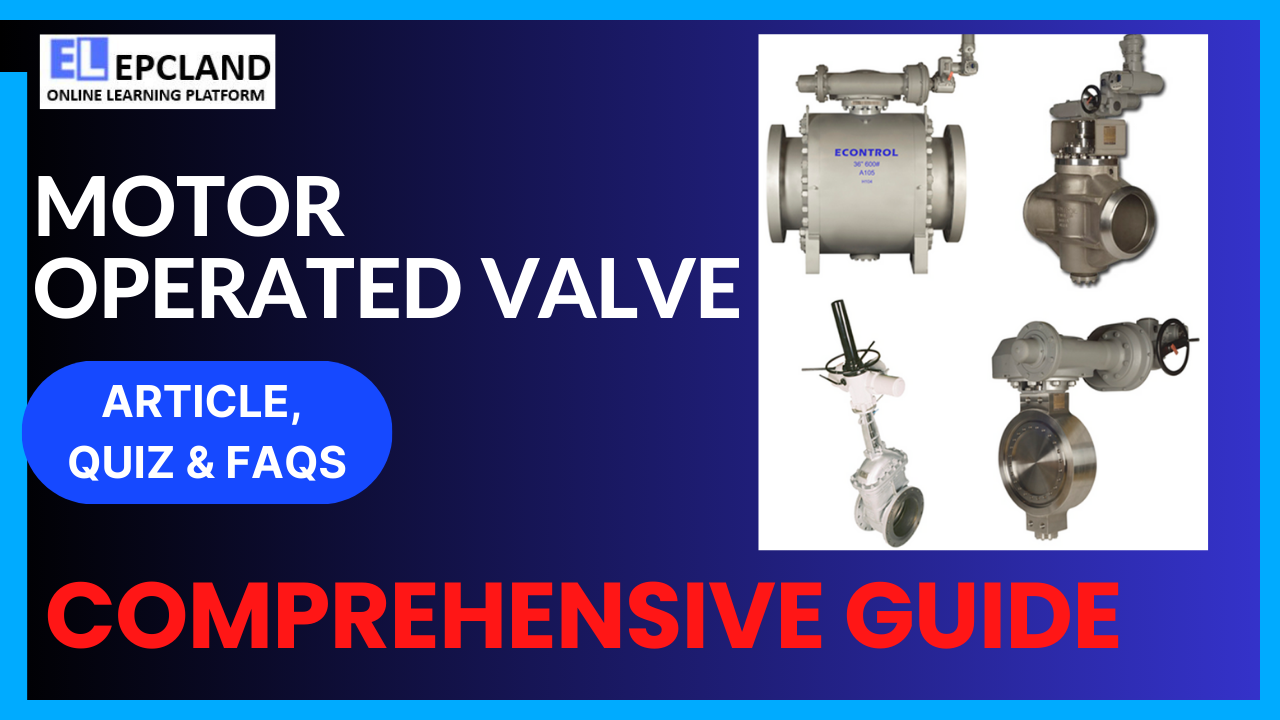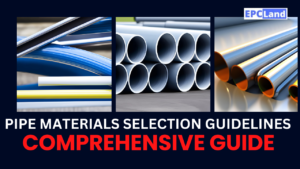Introduction
In the complex world of the oil and gas industry, where safety, efficiency, and precise control are paramount, Motor Operated Valves (MOVs) play a pivotal role. These valves are mechanical devices that regulate the flow of fluids within various processes. Their application ranges from upstream exploration and production to downstream refining and distribution. In this article, we will delve into the history, working principles, types, applications, advantages, disadvantages, and the associated codes and standards related to MOVs in the oil and gas sector.
Table of Contents
Don’t miss the Complete Course on Piping Engineering: Check Now
Enrollment Link
Brief History
The evolution of Motor Operated Valves can be traced back to the early days of the industrial revolution when engineers and inventors were grappling with the challenges of controlling fluid flows in pipelines and machinery. The need for valves that could be operated remotely and automatically became evident as industrial processes grew in complexity.
The first MOVs were simple in design, often using manual crankshafts or levers to actuate the valve. Over time, advancements in engineering and technology led to the development of electric motor-driven actuators, which brought about greater precision and reliability in valve operation. The oil and gas industry quickly recognized the potential of these motor-operated valves, integrating them into their processes for improved control and safety.

Basic Function and Working Principle
Function of MOVs
At its core, a Motor Operated Valve serves the purpose of controlling the flow of fluids in a pipeline or process system. It can open, close, or modulate the valve’s position to regulate the flow rate, pressure, and direction of the fluid. This capability is crucial for maintaining the integrity of the system and ensuring the safety of operations.
Working Principle
The working principle of an MOV is relatively straightforward. It consists of two main components: the valve body and the actuator. The valve body contains the actual valve mechanism, which can be a gate, ball, butterfly, or other types of valves. The actuator, typically an electric motor, is responsible for driving the valve’s movement.
When a control signal is received, the electric motor rotates, transferring its rotational energy to the valve mechanism through a series of gears and linkages. This motion either opens or closes the valve, depending on the desired outcome. The motor-operated valve can be controlled manually or automatically through a control system, allowing precise adjustments to be made remotely.
Types of Motor Operated Valves
Motor Operated Valves (MOVs) come in various types, each designed to meet specific operational requirements and challenges within the oil and gas industry. The choice of valve type depends on factors such as the intended application, fluid characteristics, pressure, temperature, and flow rate. Here, we will explore some common types of MOVs used in the oil and gas sector and their unique features.
1. Gate Valves
Overview:
Gate valves, also known as sluice valves, are one of the most prevalent types of MOVs in the oil and gas industry. They are characterized by a gate-like closure element that can be raised or lowered to control fluid flow.
Features:
- Full Bore Design: Gate valves typically have a full-bore design, which means that the internal diameter of the valve matches that of the pipeline, reducing flow restrictions.
- Bidirectional Flow: Gate valves can control flow in both directions, making them versatile for applications where reversing flow may occur.
- Tight Seal: When fully closed, gate valves provide a tight seal, preventing the passage of fluids.
- Isolation: They are often used for isolation purposes, such as shutting off sections of pipelines for maintenance or emergency shutdowns.
Applications:
- Isolation Valves: Gate valves are commonly used as isolation valves to control the flow of crude oil, natural gas, and other hydrocarbons in pipelines.
- Safety Shutdown Systems: They are integral components of safety shutdown systems in critical areas of oil and gas facilities.
2. Ball Valves
Overview:
Ball valves are known for their reliability and quick-acting capability, making them suitable for applications where rapid shutoff is essential. They use a spherical closure element (the ball) to control fluid flow.
Features:
- Quarter-Turn Operation: Ball valves operate with a simple quarter-turn of the handle, making them quick to open or close.
- Tight Shutoff: When closed, the ball forms a tight seal against the valve seat, minimizing leakage.
- Low Torque: They require relatively low torque to operate, making them suitable for automated systems.
- Minimal Pressure Drop: Ball valves offer minimal pressure drop across the valve, ensuring efficient flow.
Applications:
- Emergency Shutoff: Ball valves are often used in emergency shutdown systems to rapidly isolate sections of a process during critical situations.
- High-Flow Applications: Their ability to handle high flow rates makes them suitable for large pipelines and systems.
- Remote Operation: Ball valves are frequently used in remote and automated systems due to their quick response.

3. Butterfly Valves
Overview:
Butterfly valves are known for their compact design and ease of operation. They use a rotating disc as the closure element to regulate fluid flow.
Features:
- Lightweight: Butterfly valves are lightweight and easy to install, making them cost-effective.
- Quick Operation: They can be operated with a quarter-turn of the handle, allowing for rapid adjustments.
- Low Maintenance: The design of butterfly valves minimizes wear and tear, resulting in lower maintenance requirements.
- Large Flow Capacity: They excel in applications that involve large flow rates.
Applications:
- Tank Farms: Butterfly valves are commonly used in tank farms for the control of bulk liquid storage.
- Cooling Systems: They find application in cooling water systems and HVAC systems.
- Low-Pressure Systems: Butterfly valves are suitable for low-pressure and low-temperature applications.
4. Globe Valves
Overview:
Globe valves regulate fluid flow by raising or lowering a plug into or out of the valve seat. They are known for their fine control of flow rates and are often used in applications requiring precision.
Features:
- Precise Control: Globe valves provide precise control over flow rates, making them ideal for applications where accuracy is critical.
- Linear Flow Characteristic: They have a linear flow characteristic, allowing for consistent adjustments.
- Good Shutoff: When fully closed, globe valves offer a tight seal.
- Versatility: They can handle a wide range of fluids and temperatures.
Applications:
- Process Control: Globe valves are used in various process control applications within the oil and gas industry.
- Steam Systems: They are commonly employed in steam systems for temperature and pressure control.
- High-Pressure Systems: Globe valves can handle high-pressure fluids, making them suitable for critical applications.
5. Check Valves
Overview:
Check valves, also known as non-return valves, allow fluid to flow in one direction only. They are crucial in preventing backflow in pipelines and ensuring unidirectional flow of fluids.
Features:
- One-Way Flow: Check valves permit flow in one direction while blocking reverse flow, preventing contamination or damage.
- Low Resistance: They offer low flow resistance, minimizing pressure drop.
- Maintenance-Free: Check valves are typically maintenance-free, as they operate passively.
- Reliability: They ensure the integrity of pipelines by preventing backflow and protecting equipment.
Applications:
- Backflow Prevention: Check valves are used at strategic points in pipelines to prevent backflow of fluids.
- Pump Systems: They are often installed downstream of pumps to prevent damage caused by reverse flow.
- Safety Systems: Check valves play a role in safety systems to ensure the unidirectional flow of emergency fluids.
Don’t miss the Complete Course on Piping Engineering: Check Now
Enrollment Link
Applications of Motor Operated Valves
Motor Operated Valves find diverse applications across the entire spectrum of the oil and gas industry. Here are some key areas where MOVs are extensively used:
1. Upstream Operations
In upstream oil and gas operations, including drilling and production, MOVs are used to control the flow of crude oil, natural gas, and other fluids. They play a crucial role in wellhead control systems, safety shutdown systems, and flowline operations.
2. Midstream Operations
In the midstream sector, which involves transportation and storage, MOVs are employed in pipeline networks to regulate the flow of hydrocarbons. These valves ensure the efficient movement of oil and gas from production facilities to refineries or distribution centers.
3. Downstream Operations
In downstream refining and petrochemical processes, MOVs are used in various capacities. They help manage the flow of feedstock, control product quality, and facilitate the safe handling of chemicals and gases.
4. Emergency Shutdown Systems
One critical application of MOVs in the oil and gas industry is in emergency shutdown (ESD) systems. These valves are strategically positioned to rapidly isolate sections of the process in case of emergencies, such as fires, leaks, or equipment failures, preventing the escalation of potentially catastrophic events.
5. Safety Instrumented Systems (SIS)
MOV’s also play a vital role in safety instrumented systems, where they are used to implement safety functions and mitigate risks. They can quickly shut off the flow of hazardous substances to prevent accidents and protect personnel and equipment.
Advantages and Disadvantages
It’s important to weigh the advantages and disadvantages of using Motor Operated Valves in oil and gas industry projects to make informed decisions about their implementation. Here’s a breakdown:
Advantages of Motor Operated Valves
| Advantage | Explanation |
|---|---|
| 1. Precise Control | MOVs offer precise control over fluid flow, allowing for accurate adjustments to meet operational requirements. |
| 2. Remote Operation | These valves can be operated remotely, reducing the need for manual intervention in hazardous or hard-to-reach areas. |
| 3. Quick Response | MOVs can respond rapidly to control signals, making them ideal for emergency shutdown systems and safety applications. |
| 4. Automation Integration | They can be seamlessly integrated into automation systems, enabling seamless process control and monitoring. |
| 5. Reduced Maintenance | Properly maintained MOVs tend to have a longer lifespan, reducing the frequency of maintenance and associated costs. |
Disadvantages of Motor Operated Valves
| Disadvantage | Explanation |
|---|---|
| 1. Initial Cost | The upfront cost of purchasing and installing MOVs can be high, which may be a barrier for some projects. |
| 2. Maintenance Complexity | MOVs require regular maintenance to ensure proper functioning, and maintenance can be complex and costly. |
| 3. Vulnerable to Power Failures | They rely on electrical power, making them vulnerable to power failures unless backup systems are in place. |
| 4. Potential for Malfunction | Like all mechanical devices, MOVs can malfunction, and failure to actuate at the right moment can pose risks. |
| 5. Compatibility Issues | Ensuring compatibility with existing systems and processes can be challenging, requiring careful planning and design. |
Associated Codes & Standards
The oil and gas industry places a strong emphasis on safety, reliability, and compliance with industry-specific codes and standards when it comes to Motor Operated Valves. Adherence to these regulations is critical for the successful operation of oil and gas facilities. Some of the key codes and standards include:
1. API 6D: Specification for Pipeline Valves
API 6D, published by the American Petroleum Institute (API), sets the standards for pipeline valves, including Motor Operated Valves. It covers design, materials, testing, inspection, and documentation requirements for these valves.
2. API 6A: Specification for Wellhead and Christmas Tree Equipment
API 6A focuses on the design and manufacturing of wellhead and Christmas tree equipment, which often includes Motor Operated Valves. Compliance with this standard is essential for safety and reliability in upstream operations.
3. ISA-84: Functional Safety Standard
The International Society of Automation (ISA) publishes the ISA-84 standard, which addresses safety instrumented systems (SIS). MOVs used in safety-critical applications, such as emergency shutdown systems, must adhere to this standard to ensure the safety of personnel and equipment.
Don’t miss the Complete Course on Piping Engineering: Check Now
Enrollment Link
Conclusion
In the oil and gas industry, where precision, safety, and efficiency are paramount, Motor Operated Valves have become indispensable. Their ability to regulate fluid flow, whether in upstream exploration, midstream transportation, or downstream refining, makes them a critical component of modern operations. However, their implementation requires careful consideration of advantages, disadvantages, and adherence to industry-specific codes and standards. By understanding and harnessing the capabilities of MOVs, the oil and gas industry continues to advance in its quest for safer and more efficient operations.
FAQs
1. What is the primary role of Motor Operated Valves (MOVs) in the oil and gas industry?
- Motor Operated Valves are primarily used in the oil and gas industry to control the flow of fluids within various processes. They can open, close, or modulate the valve’s position to regulate the flow rate, pressure, and direction of the fluid, which is crucial for maintaining the integrity of the system and ensuring operational safety.
2. What are the key types of MOVs commonly used in the oil and gas sector, and how do they differ?
- The oil and gas industry utilizes several types of MOVs, including gate valves, ball valves, butterfly valves, globe valves, and check valves. These valves differ in terms of design, operation, and suitability for specific applications. For instance, gate valves are often used for isolation, while ball valves are known for their quick response and reliability.
3. What are some typical applications of Motor Operated Valves in the oil and gas industry?
- MOVs find diverse applications in upstream exploration and production, midstream transportation and storage, downstream refining, emergency shutdown systems, and safety instrumented systems (SIS). They are used to control the flow of crude oil, natural gas, chemicals, and other fluids, ensuring safe and efficient operations.
4. What advantages do Motor Operated Valves offer in oil and gas projects, and what are their potential drawbacks?
- MOVs provide advantages such as precise control, remote operation, quick response, automation integration, and reduced maintenance. However, they also have drawbacks, including high initial costs, maintenance complexity, vulnerability to power failures, potential for malfunction, and compatibility challenges with existing systems.
5. Are there industry-specific codes and standards that govern the use of Motor Operated Valves in the oil and gas sector?
- Yes, adherence to industry-specific codes and standards is crucial in the oil and gas industry. Some of the key standards include API 6D for pipeline valves, API 6A for wellhead and Christmas tree equipment, and ISA-84 for functional safety. Compliance with these standards ensures the safety, reliability, and regulatory compliance of MOVs in oil and gas facilities.
Recommended courses (Published on EPCLand)
- Basics of Piping Engineering
- Piping Layout Engineering
- Piping Material Engineering
- Piping Stress Analysis
- Complete Course on Piping Engineering
- Material Requisitions
- Piping Material Specifications
- Valve Material Specifications
Don’t miss the published articles on following:
Don’t miss the Complete Course on Piping Engineering: Check Now
Enrollment Link
Attempt Quiz
Question 1:
What is the primary function of Motor Operated Valves (MOV) in the Oil & Gas Industry?
Explanation: Motor Operated Valves (MOV) are primarily used to control the flow of fluids in pipelines in the Oil & Gas Industry.
Question 2:
Which type of actuator is commonly used in Motor Operated Valves (MOV) for remote control?
Explanation: Electric actuators are commonly used in Motor Operated Valves (MOV) for remote control in the Oil & Gas Industry.
Question 3:
What is the advantage of using Motor Operated Valves (MOV) in hazardous environments?
Explanation: The advantage of using Motor Operated Valves (MOV) in hazardous environments is enhanced safety and remote operation.
Question 4:
What is the purpose of fail-safe mechanisms in Motor Operated Valves (MOV)?
Explanation: Fail-safe mechanisms in Motor Operated Valves (MOV) prevent valve failure during power loss, ensuring safe operation.
Question 5:
Which type of Motor Operated Valve (MOV) is suitable for high-pressure applications?
Explanation: Gate valves are suitable for high-pressure applications in Motor Operated Valves (MOV).
Question 6:
What is the typical power source for Motor Operated Valves (MOV) in industrial settings?
Explanation: Electric power is the typical power source for Motor Operated Valves (MOV) in industrial settings.
Question 7:
What is the purpose of position feedback in Motor Operated Valves (MOV) control systems?
Explanation: Position feedback in Motor Operated Valves (MOV) control systems provides accurate valve position information for better control and monitoring.
Question 8:
What is the typical temperature range that Motor Operated Valves (MOV) can handle?
Explanation: Motor Operated Valves (MOV) can typically handle a wide temperature range, often from -40°C to 150°C.
Question 9:
What is the primary application of Motor Operated Valves (MOV) in the oil & gas industry?
Explanation: The primary application of Motor Operated Valves (MOV) in the oil & gas industry is controlling fluid flow in pipelines.
Question 10:
What is the importance of regular maintenance for Motor Operated Valves (MOV)?
Explanation: Regular maintenance for Motor Operated Valves (MOV) is essential to ensure proper functioning, extend their lifespan, and prevent failures.



